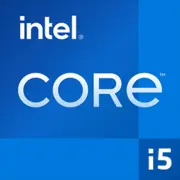Intel Core i5-5287U

Intel Core i5-5287U Broadwell: Is it Worth Choosing a Laptop with This Processor in 2025?
Introduction
In 2025, the laptop market is overflowing with processors featuring 8 cores, neural accelerators, and AI support. However, even now, we can still find devices powered by the Intel Core i5-5287U—a chip from 2015 manufactured using a 14nm process technology. Why is it still being sold? Who would benefit from such a laptop? Let’s dive into the details.
Architecture and Process Technology: What’s Inside?
Broadwell Code, 14nm, and Dual-Core Base
The Core i5-5287U belongs to the Broadwell family (5th generation Intel Core). It's the first "tick" in Intel's "tick-tock" strategy, where "tick" denotes an optimization of an existing architecture. The chip is built on a 14nm process, which was groundbreaking in 2015 but seems archaic in 2025.
- Cores and Threads: 2 cores, 4 threads thanks to Hyper-Threading.
- Frequencies: Base clock — 2.9 GHz, turbo mode — up to 3.3 GHz.
- Cache: L3 cache — 3 MB (modest even for its time).
- Integrated Graphics: Intel Iris Graphics 6100 with 48 execution units. By 2025, this is only sufficient for basic tasks.
Architectural Features
- Support for DDR3L-1600/1866 and LPDDR3-1600/1866.
- Power-saving technologies: SpeedStep, Turbo Boost 2.0.
- Lack of support for AVX-512 and other modern instructions.
Power Consumption and TDP: The Cost of Compactness
The processor’s TDP is 28W. In comparison, modern ultrabooks use chips with a TDP of 15W (e.g., Intel Core i5-1335U). The high TDP for a dual-core processor is explained by the powerful Iris integrated graphics and the features of the 14nm process.
What Does This Mean for Users?
- Heating: Laptops with this CPU require active cooling. In compact cases, fans can become noisy under load.
- Performance Balance: Turbo mode (up to 3.3 GHz) works briefly— the system quickly reaches thermal limits.
Performance in 2025: What Can You Do?
Geekbench 6
- Single-Core: 1029 — acceptable for basic tasks.
- Multi-Core: 1989 — weak even for budget modern chips (for example, AMD Ryzen 3 7320U scores around ~4500).
Real-World Scenarios
1. Office Work:
- Working with documents (Word, Excel), browsers (10+ tabs) — possible but with lag when switching between heavy web applications.
- Example: Google Meet + Slack + 5 Chrome tabs — the CPU is loaded at 80-90%.
2. Multimedia:
- Watching 1080p/4K video (with hardware acceleration) — no problem.
- Editing photos in Lightroom — long processing times for RAW files (2-3 minutes per frame).
3. Gaming:
- Iris 6100 can only handle games from before 2015 at low settings:
- CS:GO — 30-40 FPS (720p).
- The Sims 4 — 25-35 FPS (768p).
- Modern titles like Fortnite or Valorant won’t start or will run at 1-10 FPS.
Turbo Boost Mode
The processor can temporarily boost up to 3.3 GHz, but in laptops without effective cooling (like ultrabooks from 2015-2016), the frequency quickly drops back to base levels.
Use Cases: Who Is It Suitable For?
Core i5-5287U is a choice for very limited tasks:
1. Students — for lectures, working with texts, and presentations.
2. Seniors — browsing, online communication, simple games.
3. Backup Laptop — in case the main device breaks down.
Who Should Avoid It?
- Freelancers working with graphics or video.
- Gamers.
- Programmers running virtual machines or Docker.
Battery Life: How Long Will the Laptop Last?
With a TDP of 28W and a typical battery size of 40-50 Wh (for ultrabooks from 2015-2016), the runtime will be:
- Video playback: 4-5 hours.
- Office work: 3-4 hours.
Power-Saving Technologies
- Intel SpeedStep — dynamic frequency reduction during idle time.
- C-states — shutting down unused components.
However, modern processors (like the Apple M1) perform these tasks 2-3 times longer under similar conditions.
Comparison with Competitors
Intel
- Core i3-1215U (2022): 2 cores (4 threads), 8GB DDR5, Iris Xe. Geekbench 6 Multi-Core — ~4500. Laptop prices start at $400.
- Pentium Gold 7505 (2023): Comparable price but better performance in multi-threaded tasks.
AMD
- Ryzen 3 7320U (2023): 4 cores, Zen 2, Radeon 610M. Multi-Core — ~5000. Laptops from $350.
Apple
- MacBook Air M1 (2020): 8 cores, 18-hour battery life. Used models — from $500, new models — discontinued.
Conclusion: The Core i5-5287U falls short compared to even budget modern chips.
Pros and Cons
Strengths
- Low price of laptops (new devices starting from $250).
- Adequate for basic tasks.
- Compact sizes of ultrabooks on this platform.
Weaknesses
- Only 2 cores.
- High power consumption.
- No support for modern standards (USB-C, Wi-Fi 6).
Recommendations for Laptop Selection
Types of Devices
- Ultrabooks from 2015-2016: For example, Dell XPS 13 (model 9343). Pros — premium design, cons — worn-out battery.
- Budget Laptops: For instance, HP Pavilion 13.
What to Pay Attention To?
1. Battery Condition: After 10 years of use, its capacity may have dropped by 50-70%.
2. SSD Upgrade: Replacing HDD with SSD will extend the device's lifespan.
3. RAM: At least 8GB.
Advice: If the budget allows $300-400, it's better to opt for a new laptop based on Intel Core i3 12th generation or AMD Ryzen 3.
Final Conclusion
In 2025, the Intel Core i5-5287U is an option only for those who critically need to save money. It is suitable for:
- The most basic tasks: document work, watching YouTube.
- As a temporary solution.
Key Benefits:
- Extremely low price.
- Portability of ultrabooks.
However, even budget modern processors offer a better balance of price, performance, and battery life. If your requirements exceed "typing text and checking email" — look for alternatives.
Prices are current as of April 2025. They are for new devices, if such are still available for sale.
Basic
CPU Specifications
Memory Specifications
GPU Specifications
Miscellaneous
Benchmarks
Compared to Other CPU
Share in social media
Or Link To Us
<a href="https://cputronic.com/cpu/intel-core-i5-5287u" target="_blank">Intel Core i5-5287U</a>